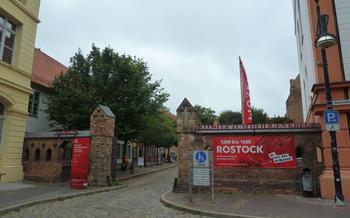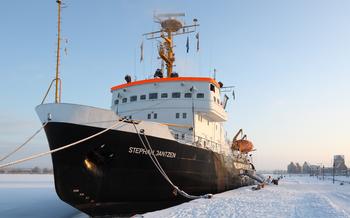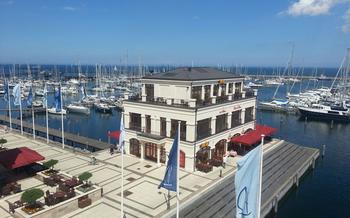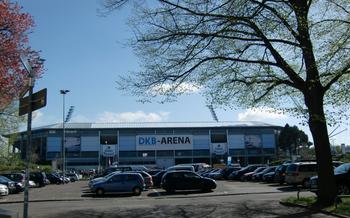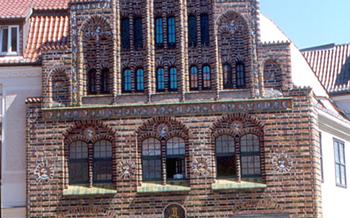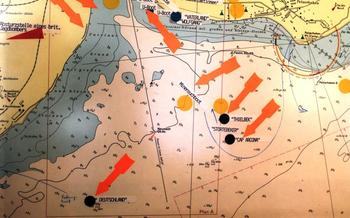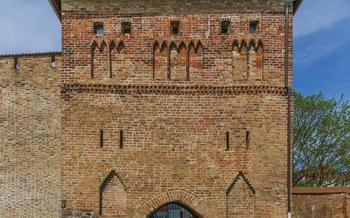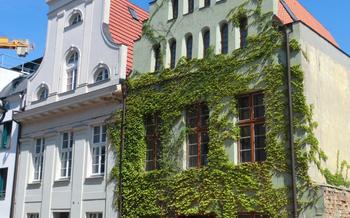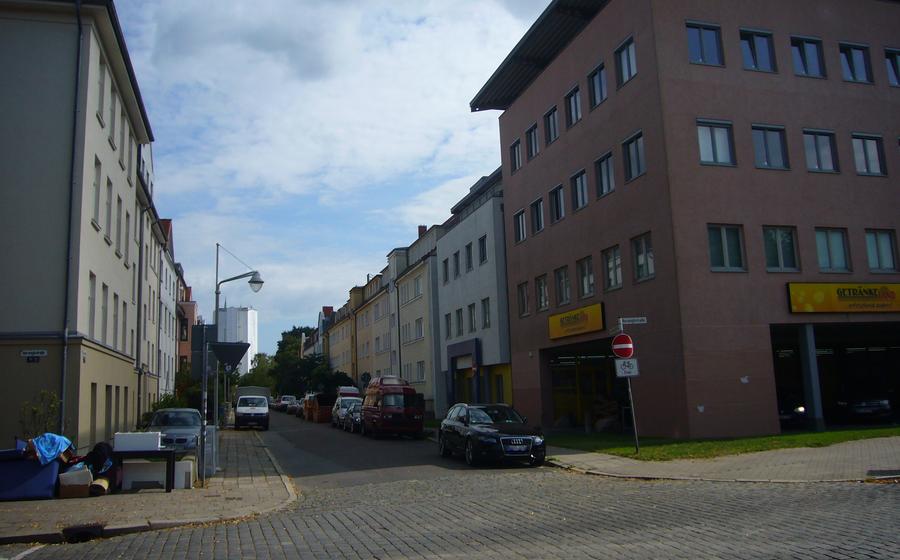
Shipbuilding and Maritime Museum (Schiffbau und Schifffahrtsmuseum)
- History and Origin
- Shipbuilding Heritage:
- Maritime History
- Interactive Experiences: Engaging Visitors with Shipbuilding and Maritime History
- Guided Tours and Workshops
- Events and Exhibitions
- Photography and Social Media
- Educational Programs
- Accessibility for Visitors with Disabilities
- Sustainability and Environmental Initiatives:
- Insider Tip:
History and Origin
The Shipbuilding and Maritime Museum in Rostock, Germany, stands as a testament to the city's rich maritime heritage and enduring connection to shipbuilding. Established in 1970, the museum was born from the desire to preserve and showcase Rostock's shipbuilding legacy, which dates back to the 13th century. The museum's inception was driven by a group of passionate individuals who recognized the importance of safeguarding the city's maritime history and sharing it with future generations.
Rostock, strategically located on the Baltic Sea, has long been a prominent shipbuilding center. The city's shipyards have produced a diverse range of vessels, from fishing boats and merchant ships to naval vessels, contributing significantly to maritime trade, exploration, and technological advancements. The Shipbuilding and Maritime Museum serves as a repository of this rich shipbuilding heritage, showcasing the skills, craftsmanship, and innovations that have shaped Rostock's maritime history.
Shipbuilding Heritage:
Rostock's shipbuilding heritage is a testament to the city's maritime prowess and industrial legacy. Once a renowned shipbuilding center, Rostock's shipyards produced a diverse range of vessels that sailed the world's oceans. From sturdy fishing boats that ventured into the North Sea to merchant ships that carried goods across continents, Rostock's shipyards were instrumental in shaping the city's economic and cultural identity.
The museum's collection showcases this rich shipbuilding heritage, featuring models, blueprints, and artifacts that tell the stories of the ships and the people who built them. Visitors can learn about the innovative techniques and technologies that were developed in Rostock's shipyards, as well as the challenges and triumphs faced by the shipbuilders.
Among the highlights of the collection are models of historic ships, such as the cog "Roland von Bremen," a replica of a medieval trading vessel that once plied the Baltic Sea. Visitors can also see models of modern ships, including the "Mecklenburg-Vorpommern," a state-of-the-art research vessel that continues Rostock's maritime tradition.
The museum's exhibits also shed light on the social and cultural aspects of shipbuilding in Rostock. Visitors can learn about the lives of the shipbuilders and their families, as well as the impact that shipbuilding had on the city's development. Through interactive displays and guided tours, the museum brings to life the stories of the people who shaped Rostock's shipbuilding heritage.
Maritime History
Rostock's maritime history is a rich tapestry woven with tales of seafaring, trade, and exploration. As a prominent Hanseatic city, Rostock played a pivotal role in the Baltic Sea trade network, connecting it to far-flung destinations and fostering cultural exchange. The city's strategic location at the mouth of the Warnow River made it a natural harbor, attracting merchants, shipbuilders, and seafarers from across the region.
Over the centuries, Rostock's maritime prowess grew, and its shipyards became renowned for their craftsmanship and innovation. From sturdy fishing vessels to nimble merchant ships and powerful naval vessels, Rostock's shipyards produced a diverse fleet that sailed the seas, carrying goods, people, and ideas. The city's maritime heritage is deeply intertwined with the Hanseatic League, a powerful alliance of trading cities that dominated the Baltic and North Sea trade routes during the Middle Ages. As a member of the Hanseatic League, Rostock enjoyed significant economic prosperity and played a crucial role in shaping the maritime landscape of the region.
Rostock's maritime history is not without its challenges. The city faced numerous conflicts and wars, including the Thirty Years' War, which devastated the Hanseatic League and led to a decline in Rostock's maritime power. However, the city's resilience and determination allowed it to rebuild and reclaim its position as a significant maritime center.
Today, Rostock's maritime heritage is celebrated and preserved through the Shipbuilding and Maritime Museum, which houses a wealth of artifacts, exhibits, and stories that bring the city's seafaring past to life. Visitors can explore the museum's collection of historic ships, maritime machinery, navigation instruments, and model ships, gaining insights into the rich maritime history of Rostock and its enduring legacy as a shipbuilding and trading hub.
Interactive Experiences: Engaging Visitors with Shipbuilding and Maritime History
The Schiffbau und Schifffahrtsmuseum offers an array of interactive exhibits that allow visitors to engage with the museum's content in a hands-on and memorable way. Visitors can step into the shoes of a shipbuilder and try their hand at riveting, welding, or assembling ship parts in a simulated shipyard environment. Interactive displays on navigation and ship design provide an immersive experience, allowing visitors to navigate virtual ships, adjust sails, and learn about the principles of buoyancy and stability. For a truly unique experience, visitors can take a virtual reality tour of a historic shipyard or immerse themselves in the sights and sounds of a bustling maritime port. These interactive elements not only enhance the overall visitor experience but also make the museum more appealing to children and visitors who want to learn more about the technical aspects of shipbuilding and maritime history.
Guided Tours and Workshops
The Shipbuilding and Maritime Museum offers guided tours that provide visitors with an in-depth exploration of the exhibits and the rich history of Rostock's shipbuilding industry. Knowledgeable guides lead these tours, sharing captivating anecdotes and stories related to the artifacts on display. Visitors can choose from various tour options, including general overviews, themed tours focusing on specific aspects of shipbuilding or maritime history, and even customized tours tailored to the interests of particular groups.
For those seeking a more hands-on experience, the museum organizes workshops and educational programs throughout the year. These workshops cover a wide range of topics, from traditional shipbuilding techniques to modern maritime technology. Participants can learn how to build model ships, navigate using celestial bodies, or even operate ship simulators. These workshops are led by experienced instructors who provide guidance and supervision, making them suitable for both beginners and enthusiasts.
Events and Exhibitions
Throughout the year, the Shipbuilding and Maritime Museum hosts a variety of temporary exhibitions and special events that delve deeper into specific aspects of shipbuilding and maritime history. These exhibitions often showcase unique artifacts, historical documents, or interactive displays that bring the stories of Rostock's maritime past to life. Visitors can explore topics such as famous shipwrecks, maritime trade routes, or the lives of notable sailors and explorers.
The museum also organizes recurring events and festivals that celebrate Rostock's rich maritime heritage. These events may include traditional boat races, maritime-themed markets, or educational workshops for children and adults. Visitors can immerse themselves in the city's maritime culture, learn about the latest innovations in shipbuilding, and enjoy live music, food, and entertainment.
By attending these events and exhibitions, visitors can gain a deeper understanding of Rostock's shipbuilding and maritime history and experience the city's vibrant maritime culture firsthand.
Photography and Social Media
The Shipbuilding and Maritime Museum encourages visitors to capture and share their experiences through photography and social media. Visitors are allowed to take photos and videos inside the exhibits, provided that they respect the museum's guidelines and copyrights. The museum also encourages visitors to share their photos and stories on social media, using designated photo spots and participating in social media campaigns. Visitors can connect with the museum on social media using the museum's handles or hashtags, to share their photos and experiences, and learn about upcoming events and exhibitions. By sharing their experiences online, visitors can help to promote the museum and its mission to preserve and showcase Rostock's rich shipbuilding and maritime heritage.
Educational Programs
The Schiffbau und Schifffahrtsmuseum is committed to educating younger generations about shipbuilding and maritime history through a variety of educational programs and initiatives. The museum offers guided tours specifically tailored to school groups, providing students with an immersive and engaging learning experience. These tours are led by knowledgeable museum educators who bring the exhibits to life and make the history of shipbuilding and seafaring accessible and captivating.
In addition to guided tours, the museum offers workshops and educational resources for students of all ages. These workshops cover a wide range of topics, from the basics of shipbuilding to the latest advancements in maritime technology. Students can participate in hands-on activities, such as building model ships or learning how to navigate using traditional instruments. The museum also provides teachers with resources and lesson plans to help them incorporate maritime history into their classrooms.
Through these educational programs, the Schiffbau und Schifffahrtsmuseum aims to inspire the next generation of shipbuilders, engineers, and maritime enthusiasts. By fostering a love of the sea and a thirst for knowledge, the museum is helping to preserve and promote the rich maritime heritage of Rostock and the Baltic Sea region.
Accessibility for Visitors with Disabilities
The Shipbuilding and Maritime Museum in Rostock is committed to providing an inclusive and accessible experience for all visitors, including those with disabilities. The museum features wheelchair ramps and elevators to ensure that all levels of the museum are accessible, and accessible restrooms are available for convenience. Visitors with disabilities can also take advantage of special services and accommodations, such as audio guides with closed captions and tactile exhibits for visually impaired visitors. To plan your visit and make the most of your time at the museum, visitors with disabilities are encouraged to contact the museum in advance to discuss any specific needs or requirements. The museum staff is dedicated to ensuring that all visitors have an enjoyable and enriching experience, regardless of their abilities.
Sustainability and Environmental Initiatives:
The Shipbuilding and Maritime Museum in Rostock demonstrates a strong commitment to sustainability and environmental responsibility. The museum has adopted various practices to reduce its ecological footprint and promote eco-friendly initiatives. It utilizes renewable energy sources, such as solar panels, to power its operations and minimizes waste through recycling and composting programs. The museum also organizes educational programs and exhibits that raise awareness about maritime environmental issues and the impact of shipbuilding on the environment. Visitors are encouraged to contribute to the museum's sustainability efforts by making environmentally conscious choices during their visit, such as using reusable water bottles and reducing single-use plastics.
Insider Tip:
For a truly unique experience, venture into the museum's hidden gem – the "Secret Shipyard." Tucked away in a secluded corner, this section showcases the intricate process of shipbuilding, from design and construction to the final launch. Witness the skilled craftsmanship of model shipbuilders as they meticulously create miniature replicas of iconic vessels, using traditional techniques passed down through generations. It's a fascinating glimpse into the behind-the-scenes world of shipbuilding, offering a deeper appreciation for the artistry and precision involved in this ancient craft.

